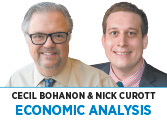Subscriber Benefit
As a subscriber you can listen to articles at work, in the car, or while you work out. Subscribe Now An inflationary fire is raging in the economy. The inflation rate is up to 7.9%, the highest since 1982. And it’s going to keep rising. Pundits and politicians are blaming all sorts of things for escalating inflation—including supply chain disruptions, corporate greed, and now the war in Ukraine. But they should be laying the majority of blame squarely where it belongs: with the Federal Reserve.
An inflationary fire is raging in the economy. The inflation rate is up to 7.9%, the highest since 1982. And it’s going to keep rising. Pundits and politicians are blaming all sorts of things for escalating inflation—including supply chain disruptions, corporate greed, and now the war in Ukraine. But they should be laying the majority of blame squarely where it belongs: with the Federal Reserve.
Of course, Fed officials aren’t blaming themselves for inflation. Rather, Chairman Jerome Powell blames inflation on shocks to the economy that are largely outside the Fed’s control. Powell’s statements give the impression that inflation just sort of happens somehow in the economy, then it’s the Fed’s job to extinguish it.
In reality, the root of inflation is excessive money creation by the central bank. When the money supply increases faster than the output of goods and services, people spend the excess money. This causes prices to rise and the value of money to fall.
The “inflation happens” rhetoric of Powell is similar to that of Arthur Burns back when he was chairman of the Fed during the Great Inflation of the 1970s. Burns blamed inflation on the diseases of monopolies, unions, and oil supply and wage shocks. Burns didn’t think his monetary policy had anything to do with inflation and called for price controls to fight it.
Things changed when Paul Volker replaced Burns as chairman in 1979. The Fed finally accepted responsibility for causing inflation and stopped creating new money so rapidly. Consequently, inflation slowed.
Neither the Great Inflation of the 1970s, nor the current inflation, can be explained solely, or even primarily, by supply disruptions. The reason is that, during both episodes, the overall dollar value of spending in the economy—which economists call nominal spending—increased rapidly. A negative supply shock doesn’t increase nominal spending. It causes the prices of goods to rise, but the quantity of goods bought falls by an offsetting amount, so the total dollar value of spending stays the same.
Historically, sustained inflation is always produced by higher government spending and money growth. And that is exactly what’s happening now, as evidenced by the 11.8% growth in nominal spending this year, the highest rate since 1984.
The problem is not that the Fed has been too slow to put out the inflationary fire. The problem is, the Fed is pouring gasoline on a fire it lit.•
__________
Bohanon and Curott are professors of economics at Ball State University. Send comments to ibjedit@ibj.com.
Please enable JavaScript to view this content.

Inflation is a worldwide problem driven by pandemic related supply-side disruptions, war and, in some countries, by pandemic-related spending policies. The US inflation rate is about 2 points higher than Europe’s and some of this difference may be due to our pandemic spending policies. But these policies prevented a massive increase in poverty and promoted economic growth. We shouldn’t apologize for this.
So, it appears that have three challenges: substantial pandemic-related supply-side challenges, war-related supply interruptions and pandemic-related spending levels. But attacking supply-side problems with interest rate increases does not solve these problems and it has consequences, particularly in interest rate sensitive occupations like construction.
Here’s another approach suggested by our home-grown Nobel Laureate Joseph Stiglitz, that would let price signals address the supply-side challenges while protecting the most vulnerable from inflation’s effects:
“a one-time “inflation adjustment” tax cut for lower- and middle-income households would help them through the post-pandemic transition. It could be financed by taxing the monopoly rents of the oil, technology, pharmaceutical, and other corporate giants that made a killing from the crisis. “
Dream on, David. The bulk of our inflation is due to our government printing money that was not earned by contributing to the GDP. PERIOD.
Bob, if that were true, then Germany would not also be suffering from higher than normal inflation.
I don’t live in Germany, David; I live here. I learned many years ago that there is no free lunch. If money is printed and distributed with no goods or services rendered for it, it is worth less than earned money. Since we have no way of distinguishing between the two, the printed and distributed with no value added money dilutes the value of money earned legitimately. This is not rocket science.